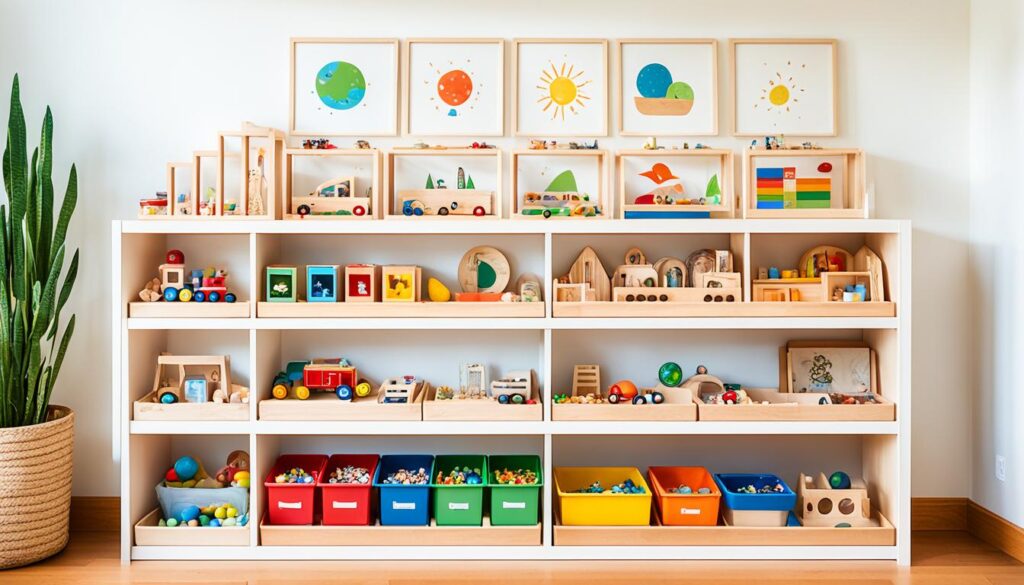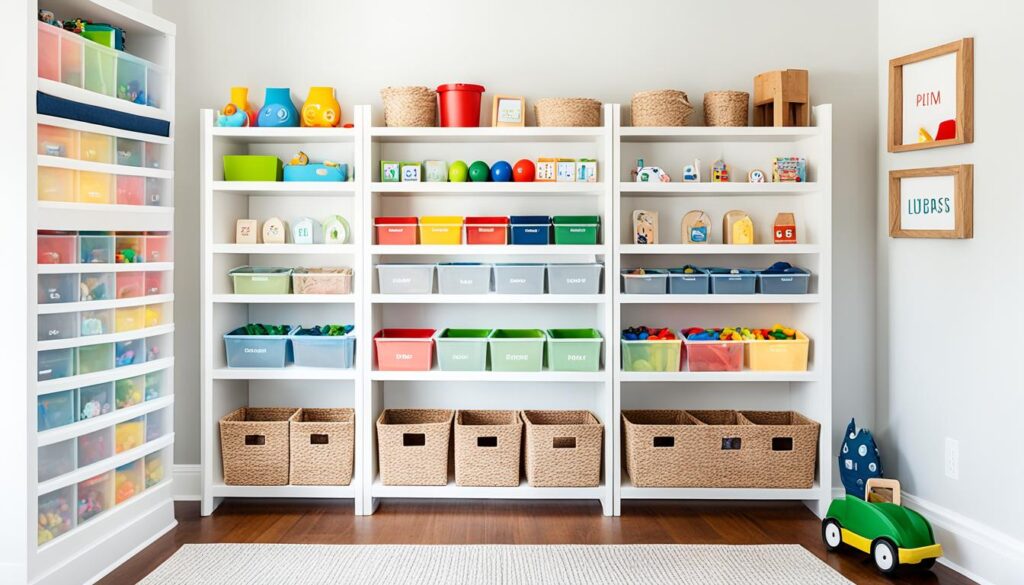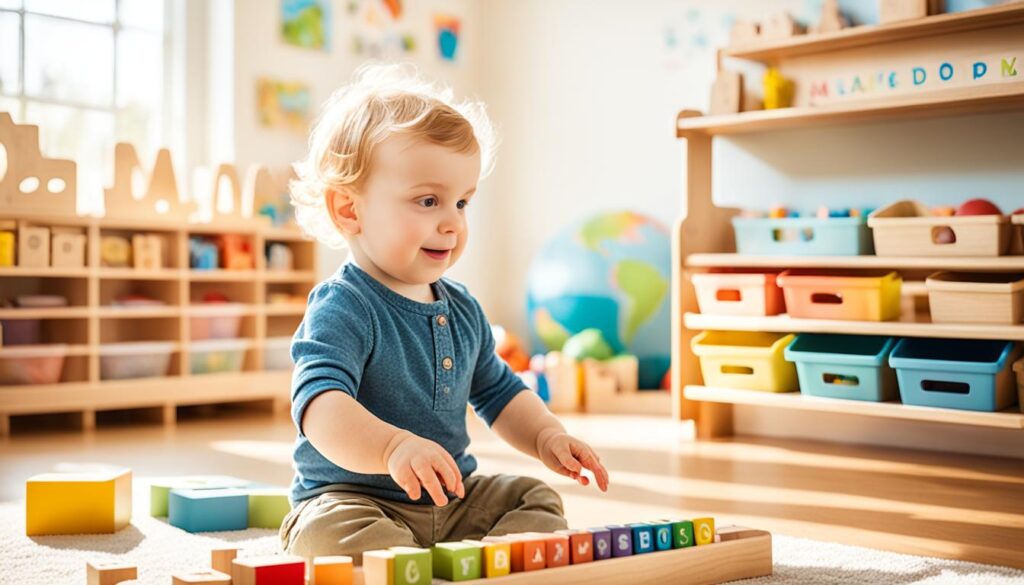Are you tired of the constant chaos and clutter in your child’s playroom? Look no further than Montessori shelves to transform this space into a well-organized haven that promotes learning and independence. Montessori shelves, also known as Montessori shelving units, provide a practical and aesthetically pleasing solution for organizing toys and materials. By incorporating Montessori principles into your playroom organization, you can create a space that encourages self-learning and discovery.
The Importance of Minimizing Toys
In a Montessori playroom, the belief is that children’s minds thrive on order. One way to achieve this order is by minimizing the number of toys in your child’s playroom. By observing your child’s preferences and eliminating broken or duplicate toys, you can create a more intentional play experience.
A smaller selection of toys allows your child to focus and explore each toy more deeply, fostering their concentration and engagement. It also makes clean-up and organization on the Montessori-inspired shelves easier and more manageable.
When deciding which toys to keep, consider those that truly capture your child’s attention and promote open-ended play. Toys that offer opportunities for creativity, imagination, and skill development are particularly valuable. By prioritizing quality over quantity, you can create a curated collection of toys that will provide endless learning opportunities for your child.
“The child has a mind able to absorb knowledge. He has the power to teach himself. The important thing is to let him use his mind…”
Remember, fewer toys don’t mean less fun. In fact, by minimizing toys and clutter, you create a more peaceful and inviting environment that allows your child to fully engage and explore their toys.
A Montessori-inspired shelf with carefully selected toys and a tidy play area.
Creating a Place for Everything
In a Montessori-inspired playroom, organization is key. By having designated places for each toy or material, you can cultivate a sense of order and promote independence in your child. DIY Montessori shelves offer a practical and customizable solution for creating a visually appealing and organized playroom.
One way to achieve this is by using shelves with open compartments or small bins for specific categories of toys. This allows you to create dedicated spaces for different types of toys, such as blocks, puzzles, or art supplies. By assigning a spot for each item, you make it easier for your child to find and put away their toys.
Montessori materials storage should be designed with accessibility in mind. Ensure that the shelves are at an appropriate height for your child to reach and that each item is easily visible. This encourages independent play and fosters a sense of ownership over their toys and materials.
When organizing the shelves, consider grouping similar items together. For example, you can have a section for building blocks, another for sensory materials, and another for books. This not only makes it easier for your child to find what they’re looking for, but it also promotes exploration and fosters curiosity.
“A place for everything, and everything in its place.” – Benjamin Franklin
The quote by Benjamin Franklin beautifully captures the essence of Montessori-inspired organization. By creating a place for each toy and material, you instill in your child a sense of responsibility and respect for their environment. They learn that everything has a purpose and a home, which can lead to a greater sense of order and harmony in their playroom.
Embracing Visual Simplicity
When it comes to creating a Montessori-inspired environment, visual simplicity is key. Montessori classroom shelves and montessori bedroom shelves should have an organized appearance that promotes a calm and inviting space for children to explore and engage in independent play.
To achieve visual simplicity, consider using neutral-colored bins or baskets to store toys and materials. This helps create a cohesive and uncluttered look on the shelves. By grouping toys or materials by category, such as art supplies or building blocks, you can further enhance organization and make it easier for children to find what they’re looking for.
Removing unnecessary visual clutter is important in a montessori-inspired playroom. By keeping only the essential toys and materials on the shelves, you create a more focused and intentional play environment. This allows children to fully engage with the items available to them and promotes concentration and exploration.
It’s also crucial to ensure that everything on the shelves is easily accessible for children of all ages. Keep items within reach by placing them at an appropriate height and ensuring that children can easily see and access them. This encourages independence and empowers children to choose and return toys on their own.
Setting Clear Expectations
Consistency and clear expectations are key in a Montessori-inspired playroom. When introducing your child to the new organization system, take the time to show them how each toy has its own place on the Montessori classroom shelves. By teaching them to take down one toy at a time and put it back before moving on to the next, you are setting clear expectations for organization and responsibility.
By reinforcing these expectations consistently, children will learn to independently navigate the shelves and take pride in putting things back where they belong. This process not only promotes a sense of order and responsibility but also helps develop important life skills such as organization and attention to detail.

Choosing the Right Storage Solutions
When it comes to Montessori-inspired toy storage, you have a variety of options to consider. It’s important to choose the right storage solutions that align with the principles of the Montessori method and meet your specific needs.
Modular Furniture for Adaptability
One option is to opt for modular furniture that can be easily rearranged as your child grows and their needs change. These versatile pieces allow you to customize the layout of your playroom and adapt it to different stages of your child’s development. Modular shelving units and storage cubes can be rearranged to accommodate different toy sizes and create a visually appealing display.
Accessible Open Shelves and Bins
Another popular choice for Montessori toy storage is open shelves and bins. These allow for easy access, enabling your child to independently choose and put away toys. Open shelves provide a clear and organized display, making it simple for children to locate and return toys to their designated place. Bins can be labeled or color-coded to further facilitate organization and encourage tidiness.
Affordable and Versatile Options at IKEA
If you’re looking for affordable and customizable shelving units, IKEA is an excellent option. They offer a wide variety of shelving units, such as the KALLAX series, that can be tailored to your space and storage needs. You can mix and match different cube sizes and add drawers or baskets for additional organization. IKEA also provides a range of bins and boxes that fit perfectly into their shelving units, ensuring a seamless Montessori-inspired storage solution.
DIY Montessori Shelves for a Personal Touch
If you enjoy hands-on projects and want to add a personal touch to your playroom, consider DIY Montessori shelves. You can create your own customized shelves using simple materials like wood or crates. DIY projects allow you to tailor the design, size, and color of the shelves to fit your space and style preferences. This is a great opportunity to involve your child in the process, fostering their creativity and sense of ownership in the playroom organization.
By carefully choosing the right storage solutions for your Montessori-inspired playroom, you can create an organized and inviting space that promotes independent play and learning. Whether you opt for modular furniture, accessible open shelves, or embark on a DIY project, the key is to align the storage solutions with the Montessori principles and meet the unique needs of your child and playroom.
Organizing Toys by Theme
One effective way to enhance the organization of toys on Montessori shelves is by grouping them according to themes. This approach allows children to explore different interests and engage in imaginative play with toys that are related to specific topics. By organizing toys in this way, you can create a more focused and enriched play experience for your child.
For example, you can dedicate one drawer to animals, another to shapes and numbers, and another to art supplies. This categorization not only makes it easier for children to find and engage with toys that align with their interests, but it also encourages them to make connections between different concepts and develop a deeper understanding of the world around them.
When toys are organized by theme, children are able to engage in more purposeful play and explore specific areas of interest more deeply. They can immerse themselves in the world of animals, experiment with different shapes and numbers, or unleash their creativity with art supplies.
The Montessori approach promotes independent learning and self-discovery. By having toys arranged by theme, children can independently select toys based on their preferences and learning goals. This autonomy and freedom of choice support their cognitive development and foster a sense of ownership and responsibility.
By organizing toys on Montessori shelves according to themes, you create an environment that encourages exploration, creativity, and independent learning for your child.
Furthermore, organizing toys by theme helps keep the play area tidy and organized. Children can easily locate toys and put them back in the designated spot when they are done playing. This promotes a sense of order and teaches children the importance of taking care of their belongings.
Remember, the ultimate goal of Montessori-inspired playrooms is to create an environment that nurtures your child’s natural curiosity and encourages their intellectual and emotional growth. By organizing toys on Montessori shelves according to themes, you provide your child with opportunities to explore different subjects, pursue their interests, and develop a deep love for learning.

Key Benefits of Organizing Toys by Theme:
- Enhanced play experience
- Deeper exploration of specific subjects
- Promotes autonomy and independent learning
- Maintains a tidy and organized play area
- Fosters a sense of responsibility
By incorporating the concept of organizing toys by theme into your Montessori shelves, you create a nurturing environment that supports your child’s natural curiosity, fosters their love for learning, and promotes their overall development.
Creating a Reading Rainbow
A reading corner can be a wonderful addition to a Montessori-inspired playroom. Not only does it foster a love for books and reading, but it also provides a cozy and inviting space for children to relax and embark on imaginative adventures.
One way to create an appealing reading corner is by organizing books on Montessori bedroom shelves in a visually striking manner. A great tip is to arrange books by color, creating a vibrant and eye-catching display. This not only adds visual interest to the space but also makes it easier for children to find and choose books based on their favorite colors.
When organizing books by color, make sure to remove any books that are too advanced or too simple for your child’s reading level. This way, the reading materials available on the shelves will be age-appropriate and accessible, ensuring an enjoyable reading experience.
Focus on the primary color of the book bindings to create a cohesive look. Select a range of hues within that color and arrange the books in a way that gradually transitions from one shade to another. This fading color effect creates a beautiful gradient that adds depth and visual interest to the reading corner.
Don’t forget to add cozy pillows or a small bean bag chair to make the reading corner even more comfortable and inviting. Including a soft rug or a small table for your child to keep their favorite books within reach can also enhance their reading experience.
“A well-designed reading corner can ignite a child’s imagination and nurture their love for reading.”
By creating a reading rainbow in your playroom, you are not only providing a dedicated space for books but also instilling a sense of curiosity and wonder in your child. They will be encouraged to explore different stories, engage in independent reading, and develop a lifelong love for books.
Conclusion
Montessori shelves provide practical and aesthetically pleasing solutions for organizing playrooms. By implementing Montessori principles, you can create a space that promotes independence and self-learning for your child. By minimizing the number of toys and creating a designated place for everything, you encourage focused play and easy clean-up. The visual simplicity of Montessori shelves creates an inviting environment, while setting clear expectations helps children develop responsibility and organization skills.
Choosing the right storage solutions, such as modular furniture or DIY options, allows you to customize the shelves to suit your needs. Organizing toys by theme further enhances the functionality of the space, enabling children to easily find toys that align with their interests and learning goals. Adding a reading corner with color-coded books provides a delightful visual display and encourages reading engagement.
By incorporating Montessori-inspired shelves into your playroom, you facilitate your child’s development and enjoyment of play. These shelves not only keep the playroom organized but also support your child’s independence, creativity, and learning. Embrace the Montessori approach to playroom organization, and watch your child thrive in a well-organized and enriching environment.
FAQ
What are Montessori shelves?
Montessori shelves are storage units designed to organize toys and materials in a way that promotes independence and self-learning for children.
What are some ideas for Montessori shelves?
Some Montessori shelf ideas include using open shelves with compartments or small bins, organizing toys by theme, and creating a visually simple and organized appearance.
Can I make my own Montessori shelves?
Yes, you can DIY Montessori shelves using simple materials like wood or crates.
How can Montessori shelves benefit a playroom?
Montessori shelves can transform a cluttered playroom into a well-organized space, encouraging focused play, easier clean-up, and promoting a sense of order.
Where can I find affordable Montessori shelving units?
IKEA offers affordable shelving units that can be customized to fit your space and storage needs.
How should I organize toys on Montessori shelves?
Organize toys by grouping them by theme to encourage exploration and align with children’s interests and learning goals.
What is the benefit of creating a reading corner in a Montessori-inspired playroom?
A reading corner can provide a visually appealing display and easy access to books, promoting independent reading and exploration.
How can Montessori shelves promote independence and self-learning?
Montessori shelves encourage children to take responsibility for their belongings, navigate the shelves independently, and reinforce clear expectations for toy organization and clean-up.
How can Montessori shelves enhance a child’s development and enjoyment of play?
Montessori shelves provide a well-organized and visually simple space that promotes focused play, independence, and a sense of order, leading to a more enriching play experience.



